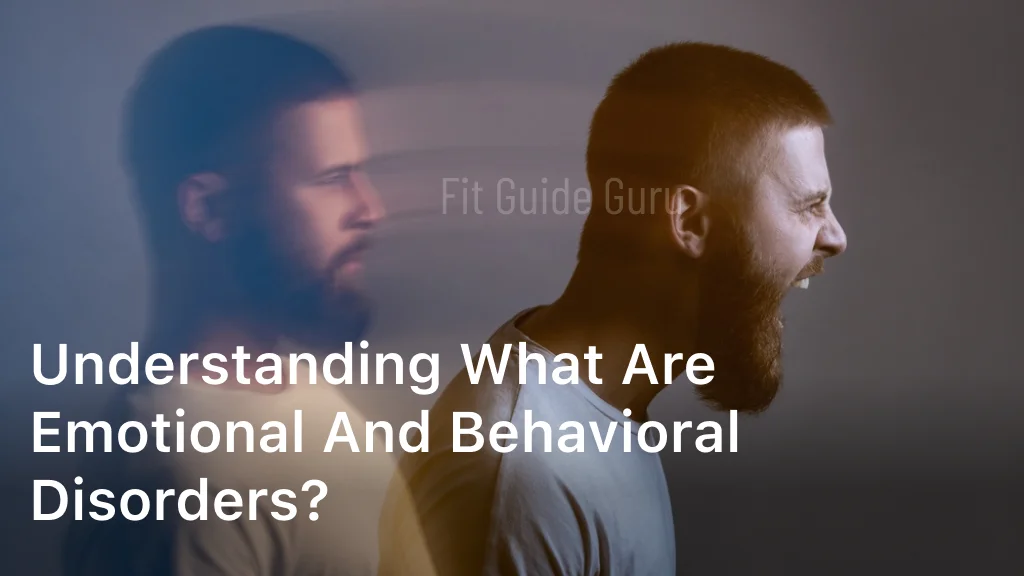Understanding What Are Emotional and Behavioral Disorders?

fitguideguru.com. Understanding What Are Emotional and Behavioral Disorders? Discover “What Are Emotional and Behavioral Disorders” with us. We unpack the complexity, causes, and effective management techniques for these disorders.
As human beings, we experience a range of emotions and behaviors that help us navigate our lives. However, for some individuals, these experiences can become intense and lead to emotional and behavioral disorders. But what are emotional and behavioral disorders, and what are their causes?
In this section, we will explore these questions, providing a comprehensive understanding of emotional and behavioral disorders and their underlying causes. By gaining insights into these disorders, we can foster greater awareness, support, and empathy for individuals who experience them.
What Are Emotional and Behavioral Disorders?
Key Takeaways:
- Emotional and behavioral disorders are conditions that affect an individual’s emotional and behavioral responses.
- Understanding emotional and behavioral disorders is crucial to support individuals who experience them.
- Causes of emotional and behavioral disorders can vary from genetic and environmental factors to psychological and social factors.
- Emotional and behavioral disorders can be managed through therapeutic interventions and counseling techniques.
- Effective treatment options for emotional and behavioral disorders can greatly improve an individual’s quality of life.

Defining Emotional and Behavioral Disorders
Now that we have a general understanding of emotional and behavioral disorders, let’s delve into their specific definition and characteristics.
Emotional and behavioral disorders, also known as EBD, refer to a wide range of conditions that affect an individual’s emotional state, behavior, and ability to learn. These conditions may manifest in different ways, including aggression, anxiety, depression, hyperactivity, impulsivity, and social withdrawal.
It’s important to note that not all emotional and behavioral disturbances indicate a disorder. These behaviors can be part of a normal reaction to stressors in a person’s life. However, when they persist and have a significant impact on daily functioning, they may be classified as EBD.
Characteristics of Emotional and Behavioral Disorders
EBD can manifest in different ways, depending on the individual and the underlying causes of the disorder. However, some common characteristics of EBD include:
- Difficulty regulating emotions and behavior
- Difficulty building and maintaining positive relationships
- Low self-esteem and self-worth
- Impulsivity and poor judgment
- Aggressive behavior towards oneself or others
- Difficulty concentrating and completing tasks
- Increased hyperactivity or withdrawal from social situations
- Difficulty adapting to change and managing transitions
Because these characteristics can manifest differently in each individual, it’s important to seek professional evaluation and diagnosis from a qualified mental health professional.
“Emotional and behavioral disorders, also known as EBD, refer to a wide range of conditions that affect an individual’s emotional state, behavior, and ability to learn.”
Types of Emotional and Behavioral Disorders
Emotional and behavioral disorders are diverse and can manifest in varying degrees of severity. In this section, we will explore some of the most common types of emotional and behavioral disorders.
Attention-Deficit/Hyperactivity Disorder (ADHD)
ADHD is a neurodevelopmental disorder characterized by difficulty with attention, hyperactivity, and impulsivity. It can affect children and adults and may persist into adulthood. Symptoms can include forgetfulness, disorganization, poor time management, and difficulty following through with tasks or instructions.
Anxiety Disorders
Anxiety disorders are a group of disorders characterized by excessive fear and worry. They can cause physical symptoms such as sweating, trembling, and rapid heart rate. Common anxiety disorders include generalized anxiety disorder, panic disorder, and social anxiety disorder.
Depression
Depression is a mood disorder that can cause persistent sadness and loss of interest in previously enjoyable activities. Other symptoms may include fatigue, changes in appetite, sleep disturbances, and feelings of worthlessness or guilt.
Obsessive-Compulsive Disorder (OCD)
OCD is an anxiety disorder that causes intrusive, unwanted thoughts and repetitive behaviors or mental acts. These obsessions and compulsions can interfere with daily life and cause significant distress.
Bipolar Disorder
Bipolar disorder is a mood disorder characterized by episodes of depression and mania. Symptoms of depression can include feelings of sadness and hopelessness, while symptoms of mania can include elevated or irritable mood, increased energy, and impulsive behavior.
Conduct Disorder
Conduct disorder is a behavioral disorder characterized by a disregard for the rights of others and a violation of social norms and rules. Symptoms can include aggression, theft, and destruction of property.
While these are just a few examples, emotional and behavioral disorders can impact individuals in a multitude of ways. It’s important to understand that each disorder may have unique symptoms and treatment approaches.
Causes and Risk Factors
Emotional and behavioral disorders are complex conditions that can be caused by a variety of factors. Research suggests that these disorders often result from a combination of genetic, environmental, psychological, and social factors.
Genetic factors: Studies have shown that various genetic factors can contribute to the development of emotional and behavioral disorders. For example, a family history of mental health disorders can increase the risk of developing these conditions. Additionally, certain genes may be associated with an increased likelihood of developing specific disorders, such as bipolar disorder or attention-deficit/hyperactivity disorder (ADHD).
Environmental factors: Environmental factors can also play a significant role in the development of emotional and behavioral disorders. Traumatic experiences, such as physical or sexual abuse, can lead to conditions like post-traumatic stress disorder (PTSD) or reactive attachment disorder. Other environmental factors, such as poverty or exposure to toxins, may also contribute to the development of these disorders.
Psychological factors: Psychological factors can also contribute to the development of emotional and behavioral disorders. For example, individuals who have experienced chronic stress may be more likely to develop anxiety or depression.
Social factors: Social factors can also play a role in the development of emotional and behavioral disorders. Factors such as social isolation, peer pressure, and societal expectations can all contribute to the development of these conditions.
Identifying Risk Factors
While the causes of emotional and behavioral disorders are complex, there are certain risk factors that may increase an individual’s likelihood of developing these conditions. Some of the most common risk factors include:
- Family history of mental health disorders
- Exposure to trauma or abuse
- Poor social support
- Chronic stress
- Substance abuse
- Experiencing discrimination or marginalization based on race, ethnicity, sexual orientation, or gender identity
It is important to note that while these risk factors may increase an individual’s likelihood of developing emotional and behavioral disorders, not everyone who experiences these risk factors will develop a disorder. Additionally, individuals who do not have any of these risk factors may still develop these conditions.
Management and Treatment
Effective management and treatment approaches are essential for individuals with emotional and behavioral disorders. These disorders can significantly impact an individual’s daily life and relationships. Treatment options may vary depending on the specific disorder and severity of symptoms.
Counseling and Therapy
Counseling and therapy can be incredibly beneficial for individuals with emotional and behavioral disorders. It provides a safe and supportive environment to discuss their challenges and feelings. Therapeutic interventions such as Cognitive Behavioral Therapy (CBT) and Dialectical Behavior Therapy (DBT) can help individuals develop coping skills, regulate emotions, and overcome self-destructive behaviors.
Medications
Medications can be prescribed in combination with counseling and therapy to manage symptoms of emotional and behavioral disorders. Antidepressants, mood stabilizers, and anti-anxiety medications can all provide relief for individuals with these disorders. However, it is essential to work closely with a healthcare provider to find the right medication and dosage.
Support Groups and Peer Networks
Support groups and peer networks can provide individuals with emotional and behavioral disorders with a sense of community and understanding. These groups can help reduce feelings of isolation and provide a safe space to share experiences and challenges.
Education and Skill Building
Education and skill-building programs can help individuals with emotional and behavioral disorders develop the necessary skills and tools to manage their symptoms effectively. Programs such as anger management or social skills training can help individuals learn new coping strategies and improve their relationships with others.
Family Therapy
Family therapy can be especially helpful for children and adolescents with emotional and behavioral disorders. It can help improve communication, reduce conflict, and provide a supportive environment for the entire family.
Overall, effective management and treatment for emotional and behavioral disorders require a holistic approach that addresses a range of physical, emotional, and environmental factors. With the right treatment and support, individuals with these disorders can lead fulfilling and productive lives.
Conclusion
As we come to the end of our exploration of emotional and behavioral disorders, we hope that you have gained a deeper understanding of these conditions. It is important to recognize that individuals with emotional and behavioral disorders face unique challenges that may affect their daily lives.
While the causes of these disorders are complex and multifaceted, it is crucial to understand that they are not the fault of the individual experiencing them. Instead, we must work to create a supportive and empathetic environment that fosters their well-being.
Through effective management and treatment approaches, individuals with emotional and behavioral disorders can receive the support they need to lead fulfilling lives. It is our responsibility to promote greater awareness and understanding of these disorders to reduce stigma and provide a more inclusive society.
Thank you for taking the time to learn about emotional and behavioral disorders with us. We hope that this knowledge will inspire you to advocate for those who may be struggling and promote greater compassion and understanding in your community.
FAQ
What are emotional and behavioral disorders?
Emotional and behavioral disorders refer to conditions characterized by persistent patterns of emotional and behavioral difficulties. These disorders can significantly impact an individual’s ability to function in various areas of life.
How are emotional and behavioral disorders defined?
Emotional and behavioral disorders are defined by specific criteria that include persistent and atypical patterns of behavior, such as aggression, impulsivity, and difficulty establishing and maintaining relationships.
What are the types of emotional and behavioral disorders?
There are various types of emotional and behavioral disorders, including attention-deficit/hyperactivity disorder (ADHD), oppositional defiant disorder (ODD), conduct disorder (CD), and anxiety disorders. Each disorder has its own distinct characteristics and diagnostic criteria.
What causes emotional and behavioral disorders?
The causes of emotional and behavioral disorders are multifaceted and can include a combination of genetic, environmental, psychological, and social factors. Some contributing factors may include family history, trauma, chemical imbalances, and adverse childhood experiences.
How can emotional and behavioral disorders be managed and treated?
Management and treatment approaches for emotional and behavioral disorders often involve a combination of therapeutic interventions, counseling, and support. These may include behavioral therapies, medication, social skills training, and creating a structured and supportive environment.





